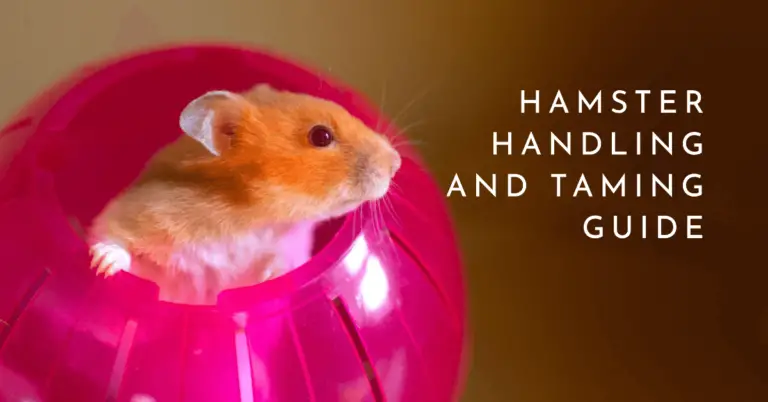Can You Leave a Hamster Alone for a Week? Essential Guidelines and Tips
Here’s an overview:
- Introduction: Understanding the Basics
- Types of Hamsters: Does Breed Matter?
- Assessing Your Hamster’s Health Before You Leave
- Setting Up a Safe and Comfortable Habitat
- Ensuring Adequate Food and Water Supply
- Maintaining Cleanliness: Bedding and Cage Maintenance
- Temperature Control: Creating the Right Environment
- Entertainment and Enrichment: Keeping Your Hamster Engaged
- Emergency Contacts: Having a Backup Plan
- Returning Home: Re-acclimating Your Hamster
- Common Misconceptions About Leaving Hamsters Alone
- Hamsters Don’t Require Much Care
- Hamsters Can Survive on Dry Food Alone
- Automated Feeders Solve All Problems
- It’s Safe to Leave a Hamster in a Cage Unattended for a Week
- Water Bottles Never Fail
- Hamsters Don’t Need Human Interaction
- Extra Bedding Will Compensate for Absence
- Exercise Wheels are Enough for Physical Activity
- Conclusion: Weighing the Pros and Cons
Introduction: Understanding the Basics
When considering whether a hamster can be left alone for an extended period, it is essential to understand the basic needs and behaviors of these small creatures. Hamsters are generally low-maintenance pets, but they still require continuous care to ensure their well-being. Unlike other pets, hamsters have specific needs related to their diet, habitat, and social interaction.
Key Points to Consider
- Dietary Needs:
- Hamsters need a consistent supply of fresh food and water.
- Their diet mainly consists of commercial hamster pellets, fresh fruits, and vegetables.
- It is crucial to avoid foods that are toxic to hamsters, such as chocolate and certain nuts.
- Habitat Requirements:
- A clean and safe cage is essential for a hamster’s health.
- The cage should have ample space for exercise and enrichment activities.
- Bedding should be regularly cleaned to prevent the build-up of harmful bacteria and ammonia.
- Social Interaction:
- Hamsters are solitary by nature but still require mental stimulation.
- Toys, tunnels, and other interactive elements should be provided to keep them engaged.
- Lack of stimulation can lead to stress and behavioral issues.
Signs of Distress
Understanding the signs of distress in hamsters is important to determine whether they can safely be left alone:
- Weight Loss: Significant weight loss can indicate inadequate food supply or health issues.
- Lethargy: A lack of energy or enthusiasm often signals that something is wrong.
- Aggression: Sudden aggressive behavior can indicate stress or discomfort.
Environmental Factors
Several environmental factors need to be regulated:
- Temperature: Hamsters thrive in moderate temperatures, usually between 65-75°F.
- Light: They require a regular light-dark cycle to mimic their natural habitat.
- Ventilation: Proper airflow is essential to maintain air quality within the cage.
Emergency Preparations
Planning for potential emergencies is crucial:
- Emergency Contacts: Have contact information for a trusted veterinarian.
- Surveillance: If possible, set up a pet camera to monitor your hamster.
- Backup Care: Arrange for a friend or neighbor to check in if you are away.
By comprehensively understanding these basic needs and considerations, pet owners can make informed decisions about leaving a hamster alone for any extended period.
Types of Hamsters: Does Breed Matter?
Understanding the different types of hamsters is crucial when considering their care requirements, particularly if one plans to leave them alone for an extended period. Here is a breakdown of common hamster breeds and relevant considerations:
Syrian Hamsters
- Size: Approximately 6 inches in length.
- Behavior: Solitary and territorial; must be housed alone.
- Lifespan: Typically 2-3 years.
- Care Requirements: Need ample space, robust exercise options, and frequent cage cleaning. They handle solitude well but require regular interaction when owners are present.
Dwarf Hamsters
Campbell’s Dwarf Hamsters
- Size: Around 4 inches.
- Behavior: Can be sociable with their species if introduced properly.
- Lifespan: Generally 1.5-2 years.
- Care Requirements: Prone to diabetes; thus, their diet must be closely monitored. Require more frequent checks and a less elaborate setup compared to Syrians.
Roborovski Dwarf Hamsters
- Size: The smallest breed, around 2 inches.
- Behavior: Extremely fast and active; usually prefer company of their kind.
- Lifespan: Up to 3-3.5 years.
- Care Requirements: Their energetic nature demands intricate enclosures and dynamic exercise toys. Weekly supervision of food and water is crucial.
Chinese Hamsters
- Size: About 4 inches.
- Behavior: Often enjoy interaction with humans and can be housed in pairs.
- Lifespan: Typically 2-3 years.
- Care Requirements: Thrive in vertically spacious cages with climbing opportunities. Like other breeds, they need periodic human attention to remain socialized.
Hybrid Hamsters
- Size: Varies, generally between 3-5 inches.
- Behavior: Behavioral traits can vary significantly.
- Lifespan: Around 1.5-2.5 years.
- Care Requirements: Owners must carefully tailor setups depending on dominant traits inherited from parent breeds. Monitoring health is essential due to potential genetic issues.
In each breed’s case, adequate planning for their unique needs is essential when contemplating any period of absence. Understanding these distinctions assists in creating a conducive environment for the hamster’s well-being.
Assessing Your Hamster’s Health Before You Leave
Before leaving your hamster alone for an extended period, it is crucial to assess its current health status. This evaluation helps ensure that the pet can withstand several days of minimal human interaction.
Physical Examination
Begin the assessment with a thorough physical examination. Look for:
- Weight: Ensure the hamster maintains a consistent weight. Rapid changes may indicate health issues.
- Fur and Skin: Check for patches, bald spots, or signs of skin irritation. Healthy fur should be smooth and shiny.
- Eyes and Ears: Eyes should be clear and bright, with no discharge. Ears must be free of wax buildup and odor.
- Teeth: Overgrown teeth can cause feeding difficulties. Ensure teeth are well-aligned and appropriately worn down.
- Paws and Legs: Examine for cuts, swelling, or abnormalities.
- Activity Level: Observe the hamster’s activity levels. Lethargy or hyperactivity may signal underlying problems.
Behavioral Checks
Monitor the hamster’s behavior over several days:
- Eating and Drinking: Check if the hamster is eating and drinking consistently. Reduced intake can indicate illness.
- Behavior: Notice any changes in behavior, such as repetitive activities or signs of stress.
- Sleeping Patterns: A regular sleep cycle is essential. Disruptions may hint at health issues.
Environmental Factors
Review the living conditions:
- Cage Cleanliness: Ensure the cage is clean, with fresh bedding.
- Temperature and Humidity: Maintain optimal conditions to avoid respiratory issues.
- Sufficient Resources: Verify adequate food, water, and chew toys are available.
Veterinary Check
If there are any concerns during the health assessment, consider a veterinary consultation. A professional can:
- Identify health issues that might not be apparent.
- Provide treatments or adjustments needed for the hamster’s well-being.
- Offer specific advice related to leaving the hamster alone for a week.
Document Health Findings
Document the examination results:
- Record any abnormalities or concerns observed.
- Note the hamster’s usual behavior and eating patterns for comparison purposes later.
- Keep a log of veterinary visits and recommendations.
Setting Up a Safe and Comfortable Habitat
Creating a safe and comfortable habitat for the hamster is crucial for their well-being, especially when planning to leave them alone for an extended period. Ensuring that their environment meets their needs can help mitigate stress and health issues.
Cage Selection
- Size and Space: Opt for a spacious cage that allows for ample movement. A minimum size of 24 x 12 inches is recommended.
- Material: Choose a cage with horizontal bars for climbing and aeration. Avoid cages with large bar spacing to prevent escapes.
- Accessibility: Ensure easy access for cleaning and feeding. Multiple doors can aid in convenient interaction.
Bedding and Nesting
- Bedding Material: Use safe, absorbent materials like aspen shavings or paper-based bedding. Avoid cedar or pine shavings due to potential respiratory issues.
- Nesting Materials: Provide soft nesting materials such as shredded paper or commercial hamster nesting products. These promote natural burrowing behaviors.
Temperature and Lighting
- Temperature Control: Maintain a stable room temperature between 65-75°F. Avoid placing the cage near drafts, direct sunlight, or heat sources.
- Lighting: Ensure natural light cycles, mimicking daytime and nighttime. Avoid exposure to continuous artificial light.
Food and Water
- Water Supply: Use a water bottle with a secure, leak-proof design. Verify that the bottle dispenses water correctly before leaving.
- Food Dispensers: Opt for gravity feeders to provide a steady food supply. Stock up pellets and fresh vegetables, checking for spoilage risks.
Entertainment and Enrichment
- Toys and Chews: Incorporate a variety of chew toys, tunnels, and climbing structures to keep the hamster engaged. Rotating toys can maintain interest.
- Exercise Wheel: Select a solid surface wheel to prevent foot injuries. Ensure it is appropriately sized for the hamster.
Safety Precautions
- Secure Latches: Double-check cage latches and doors to prevent accidental escapes.
- Hazard Prevention: Remove any small objects or toxins from the vicinity of the cage. Inspect for potential choking hazards or sharp edges.
A well-thought-out, secure, and enriched habitat contributes significantly to the hamster’s health and well-being, especially during prolonged periods of unattended care.
Ensuring Adequate Food and Water Supply
Providing sufficient food and water is paramount when planning to leave a hamster alone for a week. Here are detailed guidelines to ensure your pet remains adequately nourished and hydrated in your absence.
Food Preparation and Supply
- Dry Food Pellet Supply: Fill the hamster’s food bowl with high-quality dry pellets. These pellets typically contain balanced nutrients required for a hamster’s health.
- Distribute Food Evenly: Scatter some pellets around the cage. This encourages the hamster’s natural foraging behavior, providing both nourishment and mental stimulation.
- Fresh Foods: Include small portions of fresh vegetables and fruits. Carrots, apples, and cucumbers are suitable choices. Ensure to provide an amount that can be consumed within a day to prevent spoilage.
- Food Storage Consideration: Place food in multiple areas within the cage. Use hamster-specific containers that hinder contamination and spoilage. Ensure any fresh food is removed if it shows signs of spoilage before departure.
- Replenishment Plan: If possible, have someone check on your hamster’s food mid-week. This prevents the risk of food supply depletion or contamination.
Hydration Maintenance
- Consistent Water Source: Use a high-quality water bottle equipped with a sipper tube. Ensure it is securely attached to the cage to prevent spillage.
- Water Capacity: Fill the bottle to its maximum capacity. Check for any potential leaks before departure, as a malfunction could result in dehydration.
- Alternative Hydration: Consider adding a secondary water source. A shallow water dish can serve as a backup, though it may be prone to contamination and should be positioned away from bedding areas.
- Water Quality Check: Ensure the water provided is fresh and clean. Consider using bottled or filtered water to avoid any potential contaminants present in tap water.
- Hydration Monitoring: Enlist the help of a reliable individual to verify the water supply at least once during your absence.
Additional Tips
- Check Equipment: Inspect all feeding and watering equipment for functionality. Repair or replace any damaged items well ahead of your planned departure.
- Automated Feeders: Consider using an automated feeder and water dispenser that releases food and water at pre-set intervals.
- Vet Consultation: Consult a veterinarian for any specific dietary needs or recommendations tailored to your hamster’s health status. A professional opinion ensures a meticulous feeding plan.
Maintaining Cleanliness: Bedding and Cage Maintenance
Maintaining a clean environment is pivotal for the health and well-being of a hamster. Here are essential guidelines for bedding and cage maintenance:
Bedding
- Choose the Right Bedding:
- Opt for high-absorbency materials such as aspen shavings, paper-based bedding, or fleece liners.
- Avoid pine and cedar shavings due to harmful phenols.
- Quantity:
- Provide a minimum of 5-6 inches of bedding to accommodate the hamster’s burrowing behavior.
- Ensure the bedding layer is sufficiently thick to absorb waste and reduce odors.
- Regular Replacement:
- Replace soiled bedding regularly to maintain a clean habitat.
- Spot clean daily by removing clumped bedding and droppings.
- Perform a full bedding change weekly to promote hygiene and prevent ammonia buildup.
Cage Maintenance
- Daily Cleaning Tasks:
- Remove uneaten food and discard it to avoid mold growth.
- Wipe down the food dish and water bottle to ensure they remain sanitary.
- Weekly Deep Clean:
- Remove the hamster to a temporary, secure location.
- Empty the cage of all bedding, toys, and accessories.
- Scrub all surfaces with mild, pet-safe cleaning agents, then rinse thoroughly with water.
- Clean the toys and hideouts, ensuring no residue is left.
- Drying:
- Ensure all cleaned items are completely dry before reassembling the cage to prevent mold formation.
- Organizing:
- Rearrange items in different configurations to keep the hamster’s environment stimulating.
- Rotate toys periodically to maintain the hamster’s interest.
Additional Tips
- Monitoring: Observe for signs of illness or unusual behavior, which might indicate the need for more frequent cleaning.
- Litter Training: Consider training the hamster to use a designated litter box to simplify waste management.
- Unused Items: Store spare bedding and cleaning supplies in a dry, pest-free area.
It’s essential to adhere to these guidelines consistently, ensuring the hamster remains in a clean, hygienic environment even during extended absences.
Temperature Control: Creating the Right Environment
The environment’s temperature plays a crucial role in a hamster’s well-being. Hamsters are sensitive to extremes and require a stable, moderate climate to thrive. To ensure optimal conditions during an owner’s absence, it is vital to manage and monitor the temperature carefully.
Ideal Temperature Range
Hamsters generally thrive in temperatures between 65°F and 75°F. Deviation from this range can cause discomfort or health issues. To maintain this ideal range:
- Thermostat Adjustment: Set the thermostat within the recommended range before leaving. Consider using a programmable thermostat for consistency.
- Room Location: Place the hamster cage in a room that remains relatively stable in temperature, avoiding basements or attics where it might get too cold or too hot.
- Thermometer: Install a reliable thermometer in the room to monitor the temperature.
Managing Heat
Excessive heat can lead to heatstroke, a potentially fatal condition for hamsters. To prevent this:
- Fans and Ventilation: Utilize fans to circulate air while ensuring they do not blow directly on the cage. Adequate ventilation is crucial.
- Ice Packs: Place ice packs or frozen water bottles wrapped in cloth around the cage, but never directly inside it, to provide a cooling effect.
- Curtains and Blinds: Close curtains or blinds during the day to block direct sunlight, which can quickly elevate room temperature.
Managing Cold
Cold temperatures can induce hibernation, which is dangerous for domesticated hamsters. To keep the environment warm:
- Space Heaters: Use a low-wattage space heater to maintain room temperature, ensuring it is safe and stable.
- Cage Insulation: Cover the cage with a blanket or thermal cover, leaving some space for ventilation.
- Bedding: Provide ample bedding, as hamsters will burrow to conserve body heat. Opt for materials that offer good insulation, like shredded paper or aspen shavings.
By rigorously managing the temperature, owners can create a comfortable and safe environment for their hamster, minimizing risks associated with temperature fluctuations.
Entertainment and Enrichment: Keeping Your Hamster Engaged
Hamsters, like all pets, require stimulation and engagement to remain healthy and happy. When planning to leave a hamster alone for a week, ensuring they have sufficient entertainment and enrichment is essential.
Toys and Accessories
Providing a variety of toys and accessories can keep a hamster mentally and physically stimulated. Consider the following:
- Chew toys: Hamsters need to gnaw to keep their teeth in good condition. Wooden chews or mineral blocks are great options.
- Exercise wheel: A proper wheel allows the hamster to burn off excess energy. Ensure it is the right size to avoid spinal issues.
- Climbing structures: Platforms, ladders, and tunnels can provide avenues for exploration and exercise.
- Hideouts: A variety of hideouts can mimic natural burrows, offering a sense of security and exploration opportunities.
Foraging and Environmental Enrichment
Introducing changes to the environment can prevent boredom. Simple methods to achieve this include:
- Scatter feeding: Instead of placing food in a single dish, scatter it around the cage. This encourages the hamster to forage, simulating their natural behavior.
- Burrowing materials: Offer plenty of bedding material for digging and tunneling. Paper-based bedding, hay, or aspen shavings are suitable.
- Rotation of toys: Rotate toys and accessories every few days to maintain interest and novelty.
Sensory Stimulation
Engage a hamster’s senses to keep them occupied:
- Aromatherapy: Introducing safe scents, such as dried herbs (chamomile or lavender), can stimulate their sense of smell.
- Natural sounds: Playing gentle nature sounds can provide auditory stimulation.
Social Interaction
Though hamsters are generally solitary, occasional human interaction can prevent loneliness:
- Voice recordings: Leaving a recording of a familiar voice can be comforting.
- Supervised play: Before you leave, ensure the hamster has a session of supervised play to release energy and reduce stress.
Maintaining an enriched environment is critical to a hamster’s well-being, especially when left alone for extended periods. Preparing a stimulating habitat can help ensure your pet remains active, happy, and stress-free in your absence.
Emergency Contacts: Having a Backup Plan
While planning to leave a hamster alone for a week, having emergency contacts in place is crucial to ensure the well-being of the pet. Unexpected situations can arise, and being prepared can make a significant difference.
- Trusted Contact Person:
- Identify a reliable friend, family member, or neighbor who can check on the hamster periodically.
- Ensure this person is familiar with basic hamster care, including feeding, cleaning, and recognizing signs of distress.
- Veterinarian Contact Information:
- Provide the emergency contact person with the veterinarian’s details, including the clinic’s address and phone number.
- If possible, arrange a backup vet service, especially when the primary vet is unavailable or during holidays.
- Emergency Instructions:
- Draft a clear, concise set of instructions for the emergency contact person.
- Information should include feeding schedules, signs of ill health, and steps to take in various scenarios.
- Backup Supplies:
- Leave an ample supply of food, bedding, and cleaning materials accessible for the caretaker.
- Clearly label all items to avoid confusion and ensure they understand the quantities required.
- Communication Plan:
- Set up a daily or bi-daily check-in routine with the emergency contact, preferably through text or call.
- Establish a protocol for immediate communication in case of any issues or emergencies.
- Secure the Living Environment:
- Double-check the hamster’s living environment for potential hazards that could arise during your absence.
- Ensure cage locks and any moving parts are secure to avoid accidents.
“By failing to prepare, you are preparing to fail.” – Benjamin Franklin
Having a comprehensive emergency contact and backup plan is not just a precaution — it is a responsibility. This careful planning ensures that your hamster remains safe and cared for, providing peace of mind for both the owner and the emergency contact involved.
Returning Home: Re-acclimating Your Hamster
Upon returning home, it is crucial to reintroduce the hamster to its environment carefully. This process minimizes stress and ensures the animal quickly returns to a regular routine.
Initial Steps:
- Observation: Spend a few minutes observing the hamster in its habitat. Look for signs of stress or health issues. Ensure the water, food, and bedding are clean and adequate.
- Handling: Avoid handling the hamster immediately. Allow it time to acclimate to your presence again. Sudden interaction can cause distress and lead to behavioral issues.
Environmental Checks:
- Cleanliness: Clean the cage thoroughly if necessary. Replace any soiled bedding or old food. A fresh environment promotes a sense of security.
- Food and Water: Refill water bottles and food dishes. Ensure the food provided is fresh and suitable for hamsters.
- Temperature: Ensure the environment is at an optimal temperature. Avoid placing the cage near drafts, direct sunlight, or areas with fluctuating temperatures.
Behavioral Monitoring:
- Stress Signs: Watch for behaviors indicative of stress, such as excessive grooming, teeth grinding, or lethargy. Address any signs of distress promptly by providing a calm and quiet environment.
- Routine Observation: Re-establish a routine by feeding and interacting with the hamster at the same times each day. Consistent routines help animals adapt more quickly.
Re-establishing Bonding:
- Gradual Interaction: Begin with short, gentle interactions. Offer treats and speak softly. Patience is key in rebuilding trust.
- Play and Exercise: Gradually introduce playtime and exercise routines. Ensure any toys or exercise equipment are safe and familiar to the hamster.
Healthcare Considerations:
- Check for Illness: Inspect the hamster for any signs of illness or discomfort. Common signs include changes in eating or drinking habits, respiratory problems, or unusual lethargy.
- Veterinary Care: If any health concerns arise, consult a veterinarian promptly. Early intervention is critical for the wellbeing of small animals.
Additional Tips:
- Stress Reduction: Maintain a low-stress environment. Avoid loud noises and limit changes in the hamster’s surroundings.
- Diet: Gradually reintroduce any changes to the diet. Sudden dietary changes can lead to digestive issues.
By following these guidelines, owners can ensure their hamsters adjust smoothly after a period of absence, promoting a healthy and stress-free re-acclimation process.
Common Misconceptions About Leaving Hamsters Alone
Many people hold misconceptions about the implications of leaving a hamster unattended for extended periods. It’s crucial to address these misunderstandings to ensure the well-being of these small pets.
Hamsters Don’t Require Much Care
Contrary to popular belief, hamsters need consistent care. This includes clean water, fresh food, a clean living environment, and daily interaction. Owners often underestimate the level of commitment required.
Hamsters Can Survive on Dry Food Alone
Another common myth is that hamsters can subsist solely on a dry food diet. While dry food is a critical component, they also require fresh fruits and vegetables to meet their nutritional needs. An exclusively dry diet can lead to deficiencies and health issues.
Automated Feeders Solve All Problems
While automated feeders can dispense dry food, they fall short in providing fresh produce. Fresh food is crucial for a balanced diet, and automated feeders do not address this need. Moreover, automated systems can malfunction, leading to a lack of nutrition.
It’s Safe to Leave a Hamster in a Cage Unattended for a Week
Leaving a hamster in a cage for a week without human intervention can lead to multiple issues. Hamsters are prone to stress and anxiety when isolated for long periods, which can affect their physical health. Ventilation and cleanliness of the cage are also compromised over time, exacerbating health risks.
Water Bottles Never Fail
It’s often assumed that water bottles will consistently provide hydration. However, water bottles can become clogged or leak, posing a significant risk of dehydration. Regular monitoring is essential to ensure continuous water supply.
Hamsters Don’t Need Human Interaction
Many believe that hamsters are entirely solitary creatures and do not require any human interaction. However, regular interaction stimulates their mental well-being and guards against loneliness and depression.
Extra Bedding Will Compensate for Absence
Adding extra bedding without maintenance cannot replace daily care. Bedding can become soiled and promote bacterial growth, leading to potential infections and health hazards.
Exercise Wheels are Enough for Physical Activity
While exercise wheels offer a source of activity, they do not substitute for the enriched environment provided by regular human interaction and supervised playtime. Diverse forms of physical activity are necessary to maintain optimal health.
Addressing these misconceptions helps in providing adequate care and ensuring the overall well-being of hamsters during an owner’s absence.
Conclusion: Weighing the Pros and Cons
Leaving a hamster alone for a week requires careful consideration of several factors, each with its potential advantages and disadvantages.
Pros
- Convenience: Pet owners may find it convenient to leave their hamster alone, given their relatively low-maintenance care requirements compared to other pets.
- Self-sufficiency: Hamsters are capable of being independent for short periods, especially if provided with adequate food, water, and a safe environment.
- Cost-Effectiveness: Avoiding pet boarding fees or sitter costs can be financially beneficial for pet owners.
Cons
- Health Risks: Extended absence increases the risk of health issues going unnoticed, potentially resulting in serious complications for the hamster.
- Supply Depletion: Even with careful pre-planning, food and water supplies may deplete faster than anticipated, especially if dispensers malfunction.
- Habitat Cleanliness: A week without cleaning can lead to unsanitary living conditions, affecting the hamster’s well-being and health.
Critical Considerations
- Food and Water Supply: Ensure automatic feeders and water dispensers function correctly and hold a sufficient supply for the entire week.
- Emergency Situations: Enlist a trusted individual nearby who can check in periodically to address any emergencies that may arise.
- Environmental Safety: Verify that the hamster’s cage is escape-proof, well-ventilated, and free from hazards.
- Social Needs: Despite being relatively solitary animals, hamsters still benefit from interactions and stimuli to maintain mental health.
Practical Solutions
- Automated Systems: Invest in reliable feeders and water bottles with backup systems to mitigate the risk of malfunction.
- Caretaker Arrangement: Arrange for a neighbor, friend, or professional pet sitter to make at least one visit mid-week to check on the hamster and its supplies.
- Pre-Trip Health Check: Schedule a vet visit to ensure the hamster is in good health before the extended absence.
Leaving a hamster alone for a week has both potential advantages and drawbacks. By assessing the specific needs of the hamster and preparing adequately, pet owners can mitigate risks and ensure their pet remains healthy and safe.





